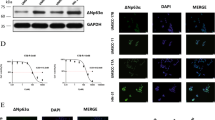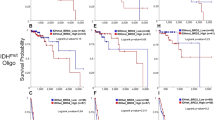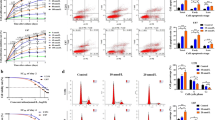Abstract
Purpose
BRCA2 defect exists in glioma and regulates drug resistance of glioma to chemotherapy. However, its role in medulloblastoma and the mechanism is not known. To investigate the effects of BRCA2 deficiency combined with Olaparib in medulloblastoma and the mechanism.
Methods
BRCA2 was knocked down by RNAi technology and cell proliferation was detected by CCK-8 assay. Cell apoptosis was determined by FACS analysis when the in vivo role of BRCA2 was explored with xenograft mice model. Western blotting technology was used to explore the mechanism of BRCA2.
Results
Knockdown of BRCA2 enhanced the inhibitory effect of Olaparib on proliferation of Daoy and LN229 cells. The inhibition rate of Olaparib on Daoy or LN229 cells was 61.1%, 66.03% in shBRCA2 group, while it was 42.9%, 41.1% in shNC group. Overexpression of RAD51 partially reversed the effect of shBRCA2. In Daoy cells, apoptotic rate was 26.9% in Olaparib group and 58.9% in Olaparib/shBRCA2 group. However, it was 33.4% after RAD51 was overexpressed. It was the same in LN229 cells. In xenograft mice model, tumor volume in Olaparib and Olaparib/shBRCA2 group was 376.12 and 84.95mm3 when tumor weight was 0.46 g and 0.12 g. In addition, the level of RAD51, RAD50, MRE11, and NBS was increased by Olaparib alone but decreased reversely after knockdown of BRCA2 in Daoy cells.
Conclusions
Knockdown of BRCA2 increases the sensitivity of medulloblastoma cells to Olaparib and strengthens the efficacy of Olaparib in vitro and in vivo. Knockdown of BRCA2 causes DNA damage repair by regulating RAD51-mediated signaling pathway in Daoy cells.






Similar content being viewed by others

References
Jasin M, Rothstein R. Repair of strand breaks by homologous recombination. Cold Spring Harb Perspect Biol. 2013;5(11):a012740.
Stover EH, Fuh K, Konstantinopoulos PA, Matulonis UA, Liu JF. Clinical assays for assessment of homologous recombination DNA repair deficiency. Gynecol Oncol. 2020;159(3):887–98.
Li H, Liu ZY, Wu NY, et al. PARP inhibitor resistance: the underlying mechanisms and clinical implications. Mol Cancer. 2020;19(1):107.
Yoshida K, Miki Y. Role of BRCA1 and BRCA2 as regulators of DNA repair, transcription, and cell cycle in response to DNA damage. Cancer Sci. 2004;95(11):866–71.
Saleem M, Ghazali MB, Wahab MAMA, et al. The BRCA1 and BRCA2 genes in early-onset breast cancer patients. Adv Exp Med Biol. 2020;1292:1–12.
Golmard L, Delnatte C, Lauge A, et al. Breast and ovarian cancer predisposition due to de novo BRCA1 and BRCA2 mutations. Oncogene. 2016;35(10):1324–7.
Chai KM, Wang CY, Liaw HJ, et al. Downregulation of BRCA1-BRCA2-containing complex subunit 3 sensitizes glioma cells to temozolomide. Oncotarget. 2014;5(21):10901–15.
Frappart PO, Lee Y, Lamont J, McKinnon PJ. BRCA2 is required for neurogenesis and suppression of medulloblastoma. EMBO J. 2007;26(11):2732–42.
Ratner E, Bala M, Louie-Gao M, et al. Increased risk of brain metastases in ovarian cancer patients with BRCA mutations. Gynecol Oncol. 2019;153(3):568–73.
Song Y, Barry WT, Seah DS, et al. Patterns of recurrence and metastasis in BRCA1/BRCA2-associated breast cancers. Npj Breast Cancer. 2019;5(44):271–80.
Yu JZ, Li H. The expression of FAT1 is associated with overall survival in children with medulloblastoma. Tumori. 2017;103(1):44–52.
Khatua S, Song A, Sridhar DC, Mack SC. Childhood medulloblastoma: current therapies, emerging molecular landscape and newer therapeutic insights. Curr Neuropharmacol. 2018;16(7):1045–58.
Kamel D, Gray C, Walia JS, Kumar V. PARP inhibitor drugs in the treatment of breast, ovarian, prostate and pancreatic cancers: an update of clinical trials. Curr Drug Targets. 2018;19(1):21–37.
Buck J, Dyer PJC, Hii H, et al. Veliparib is an effective radiosensitizing agent in a preclinical model of medulloblastoma. Front Mol Biosci. 2021;8:633344.
Roberti M, Schipani F, Bagnolini G, et al. Rad51/BRCA2 disruptors inhibit homologous recombination and synergize with olaparib in pancreatic cancer cells. Eur J Med Chem. 2019;165:80–92.
Sidhu A, Grosbart M, Sanchez H, et al. Conformational flexibility and oligomerization of BRCA2 regions induced by RAD51 interaction. Nucleic Acids Res. 2020;48(17):9649–59.
Liu YD, Lu LY. BRCA1 and homologous recombination: implications from mouse embryonic development. Cell Biosci. 2020;10:49.
Ranjha L, Howard SM, Cejka P. Main steps in DNA double-strand break repair: an introduction to homologous recombination and related processes. Chromosoma. 2018;127(2):187–214.
Quiros S, Roos WP, Kaina B. Rad51 and BRCA2–New molecular targets for sensitizing glioma cells to alkylating anticancer drugs. PLoS ONE. 2011;6(11):e27183.
Walker-Smith TL, Peck J. Genetic and genomic advances in breast cancer diagnosis and treatment. Nurs Womens Health. 2019;23(6):518–25.
Fok JHL, Ramos-Montoya A, Vazquez-Chantada M, et al. AZD7648 is a potent and selective DNA-PK inhibitor that enhances radiation, chemotherapy and olaparib activity. Nat Commun. 2019;10(1):5065.
Riches LC, Trinidad AG, Hughes G, et al. Pharmacology of the ATM Inhibitor AZD0156: potentiation of Irradiation and olaparib responses preclinically. Mol Cancer Ther. 2020;19(1):13–25.
Matsuda M, Miyagawa K, Takahashi M, et al. Mutations in the RAD54 recombination gene in primary cancers. Oncogene. 1999;18(22):3427–30.
Costanzo V. Brca2, Rad51 and Mre11: performing balancing acts on replication forks. DNA Repair (Amst). 2011;10(10):1060–5.
Vodicka P, Vodenkova S, Opattova A, et al. DNA damage and repair measured by comet assay in cancer patients. Mutat Res. 2019;843:95–110.
Lu YX, Liu Y, Yang CZ. Evaluating in vitro DNA damage using comet assay. J Vis Exp. 2017;128:56450.
Acknowledgements
This study was supported by Shanghai Municipal Health and Family Planning Commission (NSFS No. 20164Y0086), Shanghai Anticancer Association EYAS PROJECT (SACA-CY1C03), and the Cyrus Tang Foundation.
Author information
Authors and Affiliations
Corresponding author
Ethics declarations
Conflict of interest
The authors declare that they have no conflict of interest.
Additional information
Publisher's Note
Springer Nature remains neutral with regard to jurisdictional claims in published maps and institutional affiliations.
Rights and permissions
About this article
Cite this article
Yu, J., Zhang, C., Shi, W. et al. BRCA2 deficiency increases sensitivity of medulloblastoma to Olaparib by inhibiting RAD51-mediated DNA damage repair system. Clin Transl Oncol 24, 919–926 (2022). https://doi.org/10.1007/s12094-021-02742-2
Received:
Accepted:
Published:
Issue Date:
DOI: https://doi.org/10.1007/s12094-021-02742-2



